When you see a weight limit on an electric bike, it’s not just a guideline—it's a critical safety spec. Most e-bikes in the US and Australia are rated to carry somewhere between 220 and 400 pounds (100-180 kg), and that number includes you and everything you're carrying. Pushing past that limit can mess with your braking, put a huge strain on the motor, and even risk damaging the frame itself.
Why E-Bike Weight Limits Are So Important
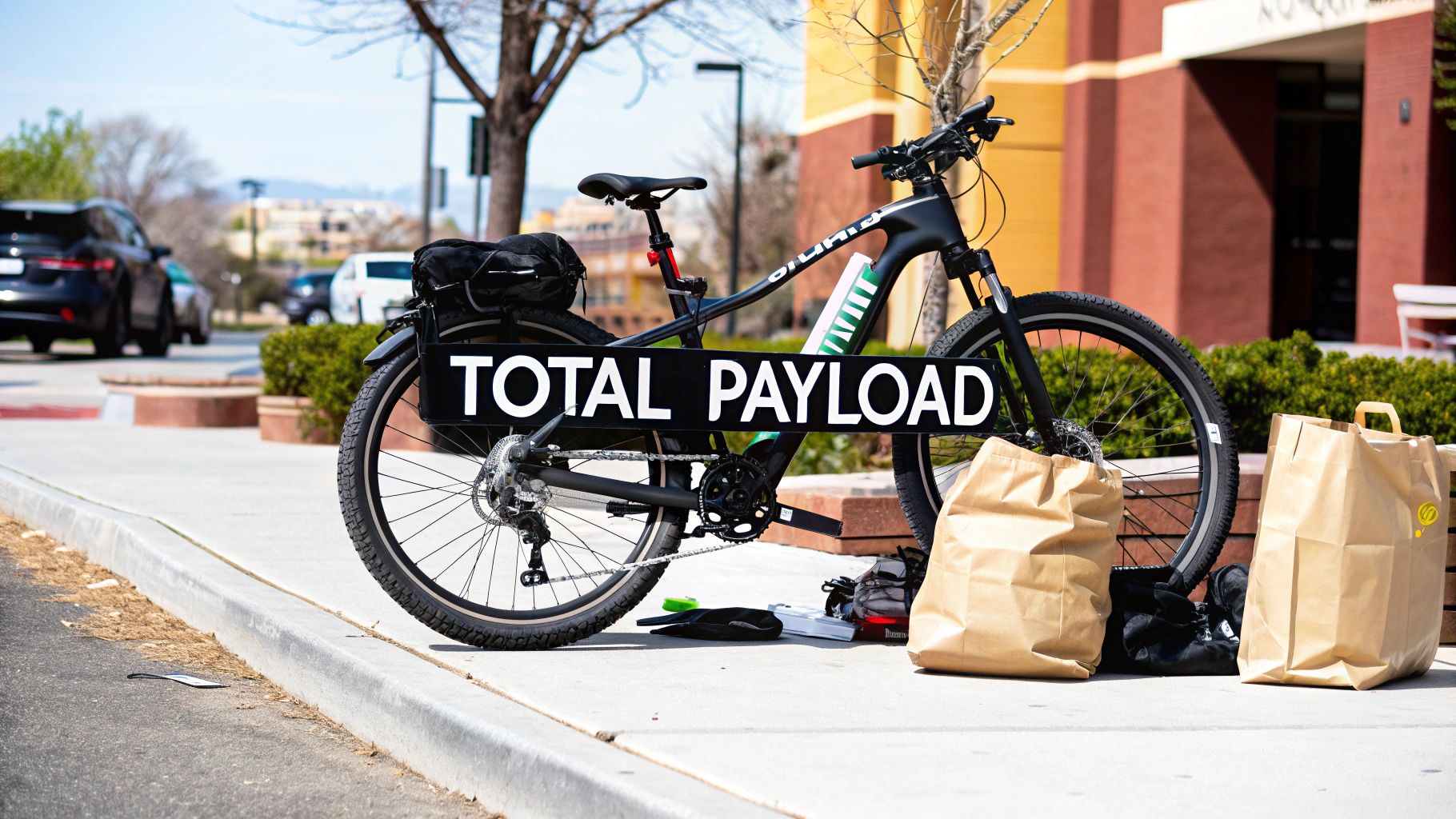
Think of an e-bike's weight limit like the maximum load sign on an elevator. It's not just a suggestion; it's there to make sure the whole system works safely and reliably. This figure isn’t just about the rider's weight, either. It’s the bike's total payload capacity, which is the grand total of everything the bike has to support.
To stay on the safe side, you have to add up a few things:
- You: Your body weight, plus whatever you’re wearing—that heavy coat, helmet, and boots all count.
- Your Gear: Don't forget your backpack, laptop bag, or that beefy bike lock you carry around.
- Your Cargo: Loading up on groceries, carrying packages, or strapping a child seat on the back? It all adds to the final number.
A bike's weight limit isn't just pulled out of thin air. It’s a direct result of serious engineering and testing. Every single part, from the welds on the frame to the spokes in the wheels, is designed to handle a certain amount of stress. Pushing past that is a real gamble with both your safety and the bike's lifespan.
The Big Deal About Overloading Your E-Bike
Ignoring the manufacturer's weight limit has real consequences for your ride's safety and performance. When you overload an e-bike, your brakes have to work way harder to slow you down, which can dramatically increase your stopping distance. That's a scary thought, especially when you're navigating busy city streets or heading down a steep hill.
Your motor and battery feel the strain, too. You'll find yourself struggling up hills that used to be a breeze, and you'll watch your battery range drop faster than you'd like. This extra stress causes parts to wear out much faster, which could mean expensive repairs down the line—and might even void your warranty.
Key Factors Defining E-Bike Weight Limits
So, what exactly determines that all-important number? A few key components do the heavy lifting. Here’s a quick look at the main players that set an e-bike's total carrying capacity.
| Component | How It Influences Weight Capacity | What to Look For |
|---|---|---|
| Bike Frame | The frame is the backbone of the bike. Its material (like aluminum or steel), tube thickness, and weld quality are the biggest factors in its strength. | Strong, reinforced frames, often found on cargo or utility models. Check for gussets at key joints for extra support. |
| Wheels & Spokes | Wheels bear the brunt of the load. Stronger rims and a higher spoke count (usually 32 or 36) distribute weight more evenly and resist buckling. | Look for double-walled rims and thicker gauge spokes. They're a good sign the bike is built for durability. |
| Brakes | The heavier the load, the more stopping power you need. Hydraulic disc brakes are much better at handling the heat and force of stopping a heavy e-bike than mechanical or rim brakes. | Prioritize hydraulic disc brakes, especially if you plan to carry heavy loads or ride in hilly areas. |
| Motor & Battery | While they don't directly set the structural limit, a powerful motor and a high-capacity battery are essential for a good riding experience when the bike is loaded down. | A motor with high torque (measured in Nm) will make climbing hills with cargo feel much easier. |
Ultimately, a bike designed from the ground up to carry more weight will have all these components working together.
Globally, most urban e-bikes are built to handle around 250–300 lbs (113–136 kg). This is a great sweet spot that works for the majority of riders plus a bit of cargo. If you want to dive deeper, you can check out the latest e-bike market trends on databridgemarketresearch.com.
The Parts That Make an E-Bike Tough
An e-bike's weight limit isn't just a number pulled out of a hat. It's a carefully calculated sum of its parts, and just like a chain, the whole system is only as strong as its weakest link. Four key components really dictate how much an e-bike can handle.
First up is the frame—the literal backbone of the bike. Engineers choose materials like high-strength aluminum or carbon fiber and design the tube shapes and thickness to withstand serious stress without bending or breaking. If you see a bike with a beefier frame and reinforced welds, that's a good clue it’s built to carry more.
Wheels, Brakes, and Motor: The Power Trio
Next, you've got the wheels. They take the full force of every bump in the road, so they have to be tough. E-bikes designed for higher weight limits almost always have stronger, double-walled rims and more spokes—usually 32 or 36 spokes—to spread the load evenly and keep the wheel from going wobbly.
You can't have "go" without "stop," and that's where the brakes come in. Powerful brakes are a must for controlling a heavier load. You'll find hydraulic disc brakes on most high-capacity e-bikes because they provide way more stopping power and handle heat better than older styles. This is all about being able to stop safely when you need to, no questions asked.
Finally, there's the motor and battery. While they don't hold the bike up, they determine how it feels to ride with a full load. The motor needs enough muscle (torque) to get all that weight moving, especially up hills, without struggling or burning out.
A stronger motor makes all the difference. If you're curious about how different motors change the ride, you can check out our guide on the best mid-drive electric bikes.
Most e-bikes you'll see on the street weigh between 40 and 70 pounds themselves, with the motor and battery making up a good chunk of that. This baseline weight plays into the total capacity, which for standard bikes is usually around 275–300 lbs. Of course, heavy-duty cargo models can push that past 450 lbs. For a deeper dive, you can explore more e-bike market insights at marketsandmarkets.com.
How Weight Capacities Vary Across E-Bike Types
One of the first things you'll notice when shopping for an e-bike is that not all of them are built the same. The type of e-bike you're looking at is a dead giveaway for its weight limit, since each style is designed for a very different job.
Think about a lightweight folding e-bike. Its whole purpose is to be portable and easy to carry, so it's not going to be the heavyweight champion. These bikes typically have a lower capacity, usually somewhere around 220–265 lbs (100–120 kg).
Your standard commuter or hybrid e-bikes are the reliable daily drivers. They're built for versatility and can handle most riders plus a bit of gear—like a backpack or a bag of groceries. You can expect a solid 250–300 lbs (113–136 kg) capacity from them, which is a great sweet spot for everyday use in both American cities and Australian suburbs.
Built for Strength and Purpose
Once you get into the more specialized models, the numbers start to jump. Electric mountain bikes (e-MTBs), for example, are made to take a beating on rugged trails from Moab to the Blue Mountains. Everything from the frame to the suspension is beefed up, allowing them to support riders and their gear up to 275–325 lbs (125–147 kg). That sturdy build is non-negotiable when you’re dealing with drops and rough terrain.
And then you have the true powerlifters of the e-bike world: cargo bikes. These machines are engineered from the ground up to haul serious loads, whether it's kids, groceries, or delivery packages. It's common to see their weight limits soar to 350–400 lbs (158–181 kg), with some heavy-duty models pushing even higher.
The infographic below really nails down why these bikes can handle more weight—it all comes down to beefier components.
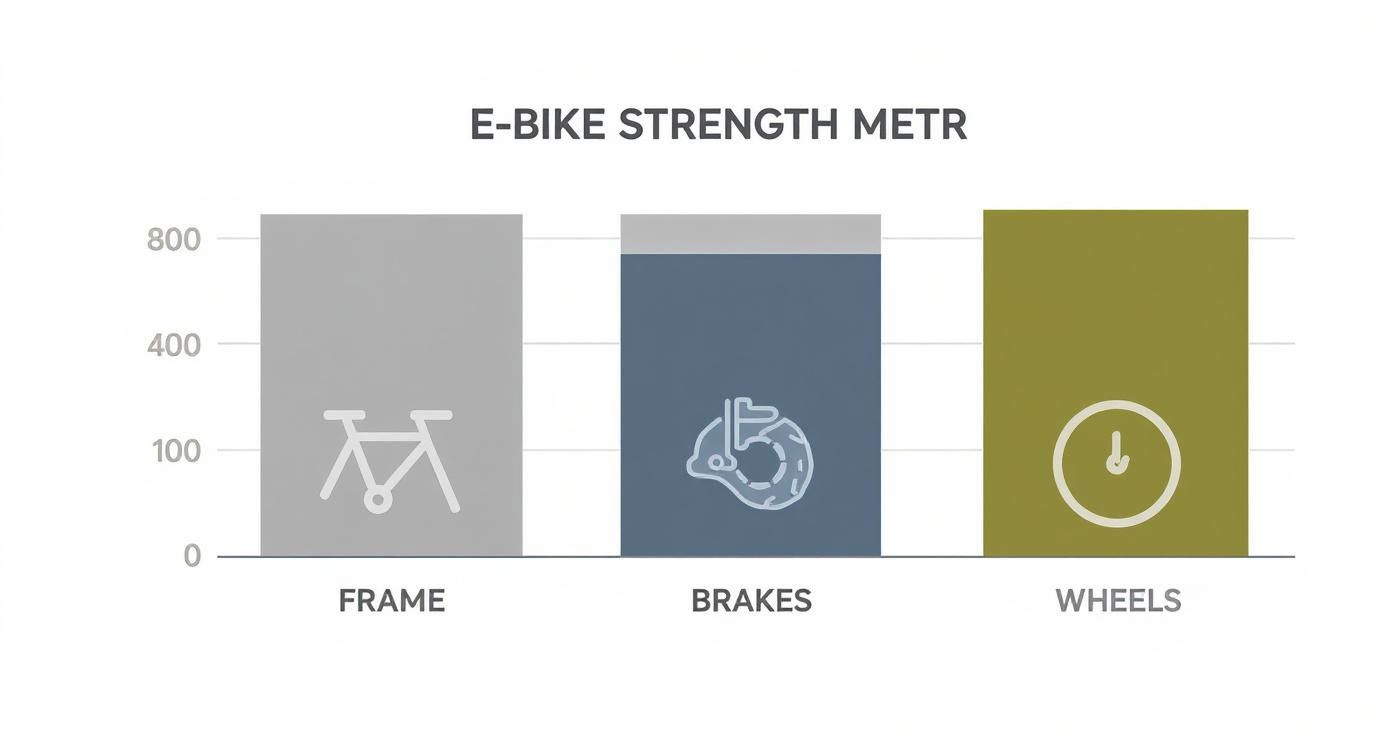
As you can see, a stronger frame is the backbone, but you also need more powerful brakes and tougher wheels to safely manage all that extra weight.
Comparing E-Bike Weight Limits by Model
To make it even clearer, let's break down the typical weight capacities you can expect from different e-bike styles. This table gives you a quick snapshot of what to look for based on how you plan to ride.
| E-Bike Type | Average Weight Capacity (lbs) | Average Weight Capacity (kg) | Ideal Use Case |
|---|---|---|---|
| Folding | 220–265 lbs | 100–120 kg | Urban commuting, portability |
| Commuter/Hybrid | 250–300 lbs | 113–136 kg | Daily errands, city riding, leisure |
| Mountain (e-MTB) | 275–325 lbs | 125–147 kg | Off-road trails, rugged terrain |
| Cargo | 350–400+ lbs | 158–181+ kg | Hauling groceries, kids, or goods |
This shows just how purpose-built each bike is. You wouldn't use a folding bike to haul lumber, and you wouldn't take a cargo bike down a technical singletrack trail.
It's also interesting to see how regional markets influence design. Here in the US and Australia, for instance, manufacturers tend to build bikes with higher weight limits, and it's pretty easy to find models rated for up to 300 lbs (136 kg). It’s all about meeting local demand, a trend you can see reflected in market reports. If you're tackling big climbs, finding a bike with both a strong motor and a high weight capacity is key—check out our guide on the best electric bikes for hills to see some top contenders.
How to Find Your E-Bike's Official Weight Limit
So where is this all-important number hiding? Thankfully, manufacturers don't usually make you hunt for it, since it’s a critical piece of safety information. You just need to know the three most common places to look.
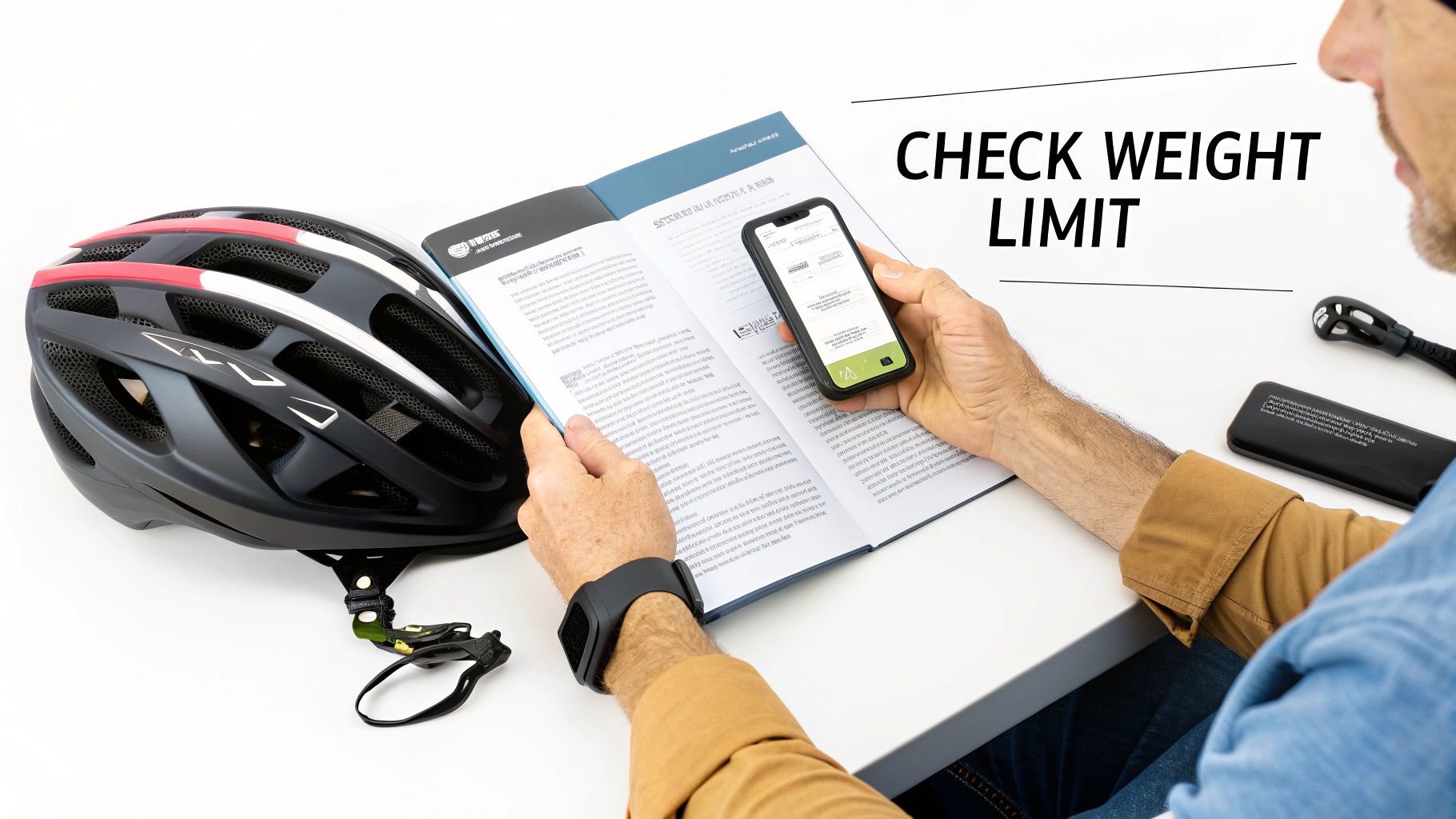
Your first stop should always be the user manual that came with your bike. Flip to the technical specifications section, and you'll find the most reliable details straight from the source.
If you’ve long since recycled the manual (we've all been there), head over to the brand's official website. Find your e-bike model, and the weight capacity is almost always listed right there on the product page.
Lastly, give the bike itself a quick once-over. Many e-bikes have a small sticker somewhere on the frame—often near the head tube or bottom bracket—that lists the maximum load and other key specs.
Rider Weight vs. Total Payload
Now, here's where things can get a little tricky. You'll often see two different terms used, and it's crucial to know what they mean.
- Rider Weight: This is exactly what it sounds like—it’s the maximum weight for just the person riding the bike.
- Total Payload / Maximum Gross Vehicle Weight (MGVW): This is the number that really matters. It’s the grand total of everything: the rider, the bike itself, and any gear you've loaded on, from panniers to a child seat.
Always, always base your calculations on the total payload or MGVW. This is the true limit the bike's frame, wheels, and brakes were built to handle safely as a complete system.
To figure out your own load, just do some quick math. Add your body weight to the weight of everything you plan to carry. That's the number you need to keep under the bike's total payload limit.
Finding the Right E-Bike for Heavier Riders or Hauling Cargo
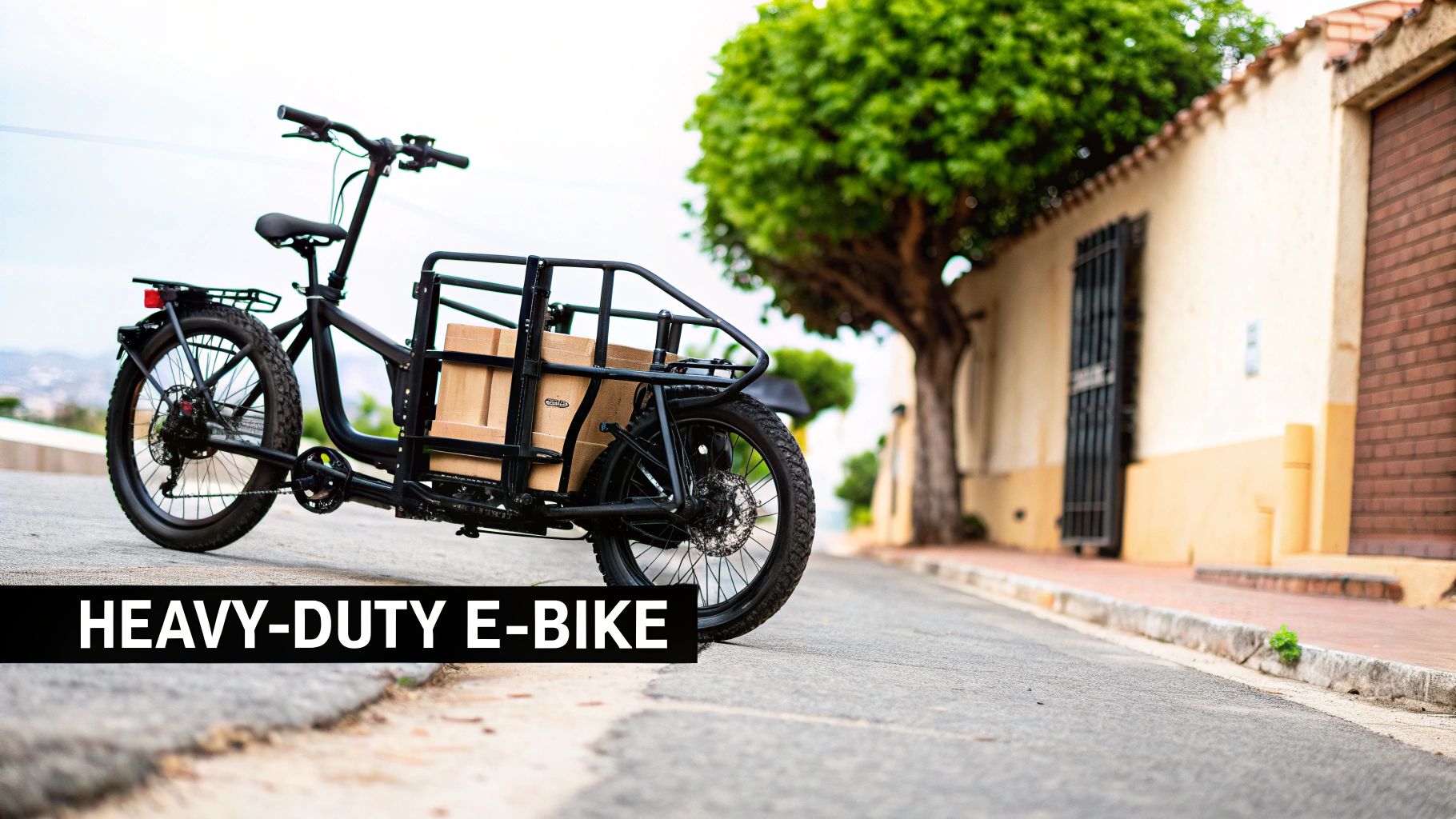
Let's be real: if you're a bigger rider or plan on loading your bike up with groceries, gear, or even a child seat, your average e-bike just isn't going to cut it. You need a machine that's built from the ground up to handle the extra load.
Trying to push a standard bike past its weight limit isn't just a recipe for poor performance—it’s a serious safety risk. The best move is to invest in an e-bike specifically designed for higher capacities. These heavy-duty models are engineered for strength, giving you a safe, stable, and reliable ride every single time.
What Makes a Heavy-Duty E-Bike Different?
When you start shopping, you’ll notice that true heavy-duty e-bikes share a few key traits. These aren't just nice-to-haves; they're essential for anyone who needs their bike to handle more than the average load.
- A Beefed-Up Frame: Forget flimsy. Look for frames made from high-strength aluminum or steel alloys, often with visibly thicker tubes and reinforced welds, especially around the headtube and bottom bracket.
- A Powerful Motor: A mid-drive motor is usually the best bet here. It delivers torque directly to the cranks, making it much easier to power up hills when you're fully loaded.
- Hydraulic Disc Brakes: When you've got a lot of weight, you need serious stopping power. Hydraulic brakes offer far more control and fade less under heat than their mechanical counterparts.
- Tough-as-Nails Wheels: The wheels take a beating. Look for double-walled rims and a high spoke count—at least 36 spokes—to prevent them from buckling under stress.
Finding the right model can completely change your riding experience. If you want a deeper dive, check out our guide on the best e-bike for heavy riders.
Here's a pro tip: How you load the bike is just as important as the bike itself. Always balance your cargo, keeping the heaviest items low and centered to maintain stability. An unbalanced load can make the bike tricky and dangerous to handle.
Don't forget that a hardworking bike needs a little extra love. Keep a close eye on your tire pressure, brake pads, and spoke tension, as these components wear out much faster under heavy loads. A little regular maintenance goes a long way.
Got Questions About E-Bike Weight Limits? We've Got Answers.
When you're digging into the world of e-bikes, the topic of weight limits can feel a bit confusing. But getting the right info is crucial for your safety and for making a smart buy. Let's clear up some of the most common questions riders have.
What Really Happens If I Go Over My E-Bike's Weight Limit?
It's tempting to think the listed weight limit is just a suggestion, but pushing past it is a serious gamble. Your bike won't just crumple underneath you the second you go over, but you're putting a ton of extra stress on pretty much every single part.
First, you'll notice your brakes aren't as effective. It'll take you longer to stop, which is a big deal in an emergency. The motor will have to work overtime, especially on climbs, which can cause it to overheat and will absolutely tank your battery range.
Over the long haul, this constant strain leads to premature wear and tear on the frame, wheels, and suspension. Hitting a nasty pothole could be the final straw, causing a part to fail when you least expect it. On top of that, you'll likely void your warranty, leaving you on the hook for expensive repairs.
Can I Just Upgrade Parts to Carry More Weight?
I hear this one a lot, but the short answer is a hard no. You can absolutely swap out parts—like getting stronger wheels or beefier brakes—to make the bike more durable, but you cannot increase the weight limit of the frame itself. That number is baked into the bike's engineering, material, and design.
Think of it like the load limit on a highway bridge. You can repave the road surface, but that doesn't change how much weight the underlying steel structure can handle. Upgrading components might make the ride feel a bit more solid, but it doesn't change the frame's breaking point. The only truly safe way to get a higher capacity is to buy an e-bike built for it from the ground up.
The manufacturer's stated electric bike weight limit is a safety rating for the entire bike as a system. The frame is the heart of that system, and its capacity is non-negotiable.
Does the Weight of the Bike Itself Count Towards the Limit?
This is a great question, and honestly, it's a common point of confusion because manufacturers use different terms. Some will list a "Maximum Gross Vehicle Weight" (MGVW). This is the big one—it includes the weight of the bike, the rider, and any cargo you're carrying.
Other brands might state a "payload capacity," which is just the weight of you and your stuff (your backpack, groceries, etc.). Your best bet is to always check the bike's manual or the company's website. If you can't find a clear answer, play it safe and assume the listed limit includes everything: bike + rider + gear.
Are There Any Good E-Bikes for Riders Over 300 lbs?
Yes, absolutely! The market has really stepped up here. While a lot of standard e-bikes top out around 275-300 lbs (125-136 kg), there are now plenty of fantastic options for heavier riders.
You'll find brands that specialize in heavy-duty e-bikes built with reinforced frames, more powerful motors, and tougher components all around. They're designed to deliver a safe, reliable, and fun ride. When you're searching, try using phrases like "heavy-duty e-bike" or "e-bike for big and tall riders" to find models rated for 400 lbs (181 kg) and beyond.
At Punk Ride LLC, we carry a huge variety of electric bikes to fit every kind of rider. Whether you need a daily commuter, a weekend explorer, or a serious cargo hauler, we’ve got a model with the right specs for you. Check out our collection and find your perfect ride today at https://www.punkride.com.




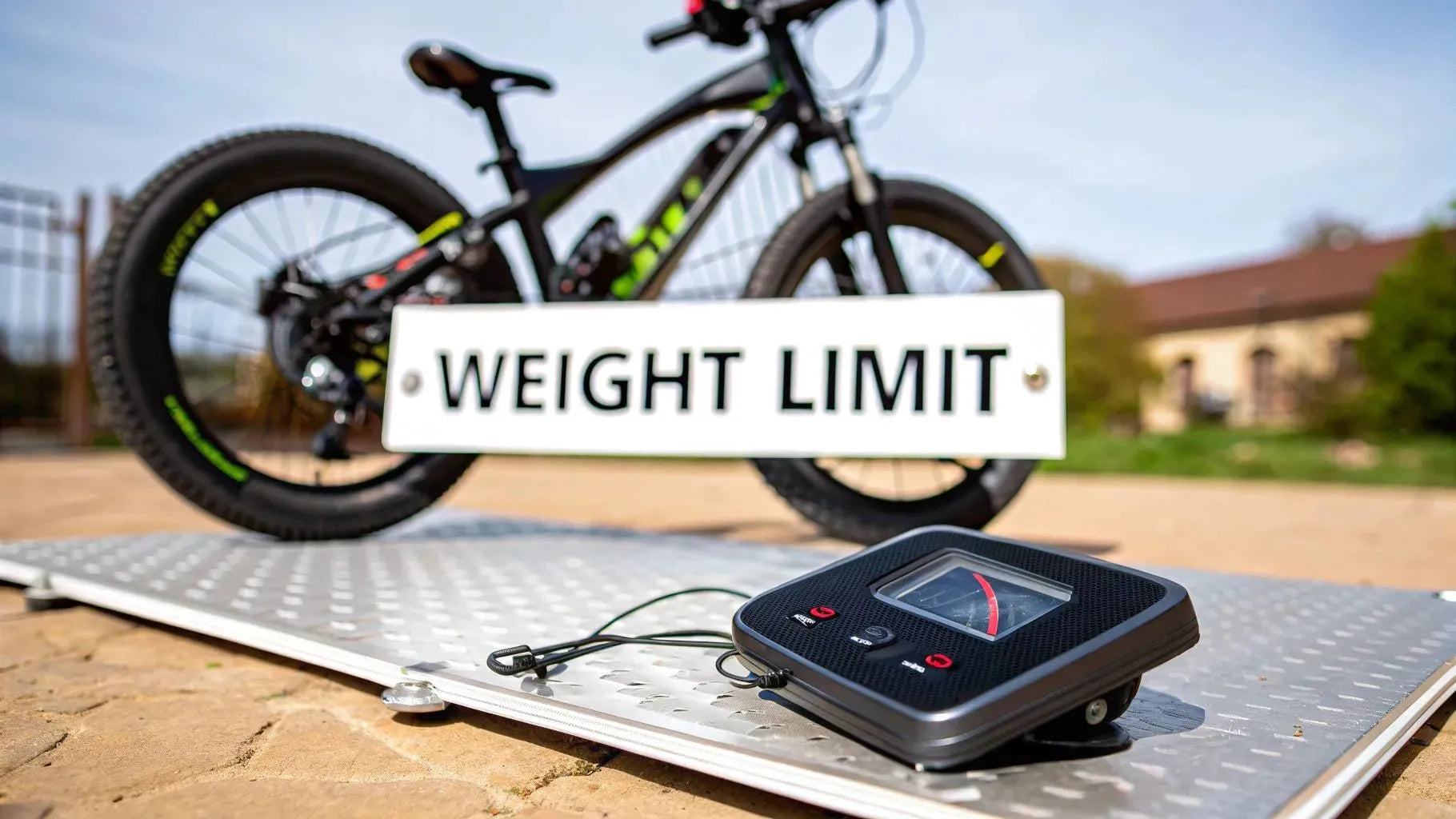
Share:
Electric Scooter vs Electric Bike Which Is Best For You
How to Lock Up a Scooter and Beat the Thieves